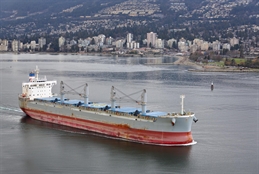
Canada’s two big Pacific gateways for ocean freight are looking to build new facilities to cope with projected growth. The slowdown in global trade has not bypassed them entirely, but the ports of Vancouver and Prince Rupert are still showing increases in their traffic this year.
“While Canada is certainly not exempt from the challenges impacting global trade, the diverse range of trading partners and cargo handled through the Port of Vancouver ensures the entire port remains resilient, despite variations in any one sector or commodity,” said Robin Silvester, CEO of the Vancouver Fraser Port Authority, when the port tabled its results for the first six months of 2019.
The port’s tonnage climbed 0.5% during the period, while container throughput was up 3.5%.
A closer look at the details reveals a more complex picture, more of a mix of light and shadow. The rise in container traffic was driven by a 1.3% increase in exports, whereas imports shrank 2.8%. Regarding commodities, grain exports climbed 8.5% to new heights, with wheat and other crops offsetting a drop in canola exports. Breakbulk (down 1.1%), bulk liquid (26.2% lower) and auto shipments (down 4%) all showed declines.
The results from Prince Rupert show fewer shades of grey. Container traffic rose 9% in the first half of the year, with loaded TEUs up 5%. Export tonnage and container volume both increased 10%, while grain exports led bulk commodities with a 16% gain.
Projections for both ports see ongoing growth. Canada’s West Coast container ports are expected to be full by the mid-2020s.
Prince Rupert in particular is expected to maintain its rapid momentum to see volumes rise beyond the 50-million-tonne mark within the next decade. Pundits predict that it will rise to become Canada’s second-largest port within the next five years.
The port authority’s master plan, which was unveiled in May, calls for the expansion of its Fairview container terminal as well as the construction of a second container facility to cope with anticipated traffic growth. The second terminal will have a capacity of 2.5 million TEUs.
The Vancouver Fraser Port authority is also gunning for a new container terminal, arguing that expansion of the existing three facilities would not be enough to meet projected demand. It wants to have a second container terminal at Roberts Bank, where the Deltaport facility is located.
For now, Vancouver is reconfiguring and expanding the Centerm container terminal. The project, which will boost the facility’s capacity by 60%, is scheduled for completion by the beginning of 2022.
Canada’s two Class I rail operators are also investing in capacity upgrades on the West Coast. CP has built a new compound for automotive traffic at the port of Vancouver. CN, the only Class I rail carrier serving Prince Rupert, has spent C$400 million (US$295 million) in 2018 and 2019 on infrastructure upgrades serving the two main Pacific gateways.
International intermodal volumes from Asia that are funnelled through both Prince Rupert and Vancouver to serve markets in the US Midwest make up about 5% of CN’s revenues, according to the rail operator.
The federal government in Ottawa is also chipping in. On September 5, it announced C$150 million (US$110 million) funding for Prince Rupert to support three infrastructure projects designed to facilitate throughput and fuel further growth. This includes C$60.6 million for improved facility access via bridge and causeway and C$49.8 million towards rail infrastructure to serve an export logistics platform project.
In July, Ottawa announced C$100 million in funds to improve cargo traffic flows in and out of the port of Vancouver. Both large Pacific gateways had experience access bottlenecks, which had led to longer dwell times. Emphasizing faster transit times from Asia to the US Midwest, both ports rely on unhampered flows of traffic, particularly rail movement. Investment looks set to continue to flow to Prince Rupert and Vancouver.
By Ian Putzger
Correspondent | Toronto




